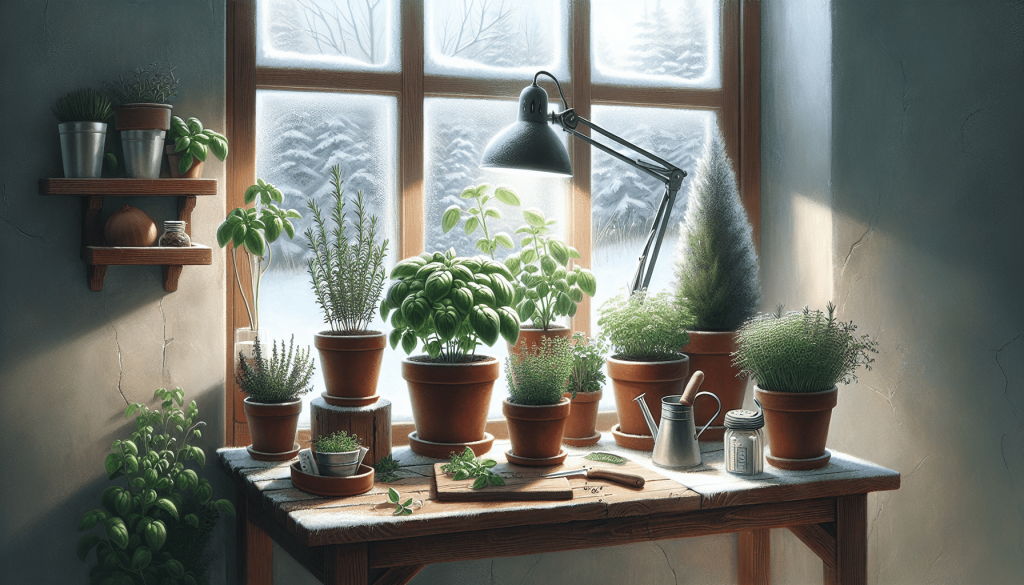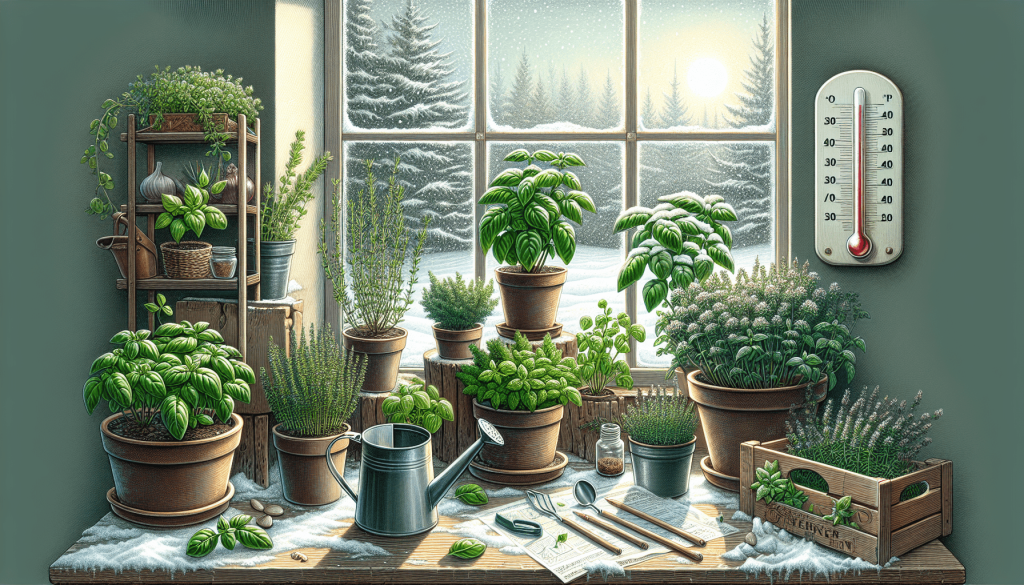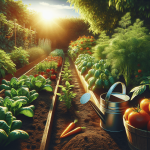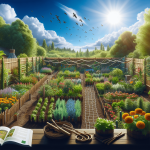This post may contain affiliate links. As an Amazon Associate, we may earn commissions from qualifying purchases.
During the winter months, when the chilly weather prevents you from tending to your beloved outdoor herb garden, you may find yourself wondering, “How do I grow herbs indoors?” Fear not, because bringing the vibrant flavors and fragrances of fresh herbs into your home is easier than you might think. With a few simple tips and tricks, you can create a cozy oasis of greenery in your kitchen or living space, ensuring a continuous supply of aromatic and flavorful herbs throughout the cold winter months. So, grab your gardening gloves and let’s explore the world of indoor herb gardening together!
Choosing the right herbs
Consider the availability of sunlight
When choosing herbs to grow indoors, it’s important to consider the amount of sunlight available in your home. Most herbs require at least six hours of direct sunlight each day to grow and thrive. Take a look around your living space and identify areas that receive the most sunlight. These locations could be near windows or on well-lit countertops. By selecting herbs that can tolerate lower light conditions, you’ll increase your chances of success.
Select herbs that thrive indoors
Not all herbs are well-suited for indoor growing, so it’s important to choose varieties that can thrive in an indoor environment. Some popular herbs that do well indoors include basil, mint, parsley, chives, and thyme. These herbs are known for their adaptability and ability to thrive in containers. Research the specific requirements of each herb to ensure you are providing the optimal conditions for their growth.
Choose herbs with similar care requirements
When selecting herbs to grow indoors, it’s helpful to choose varieties that have similar care requirements. This will make it easier to provide consistent care and maintenance for your plants. Consider factors such as water needs, temperature preferences, and humidity requirements. By choosing herbs with similar care requirements, you can streamline your indoor gardening routine and ensure the health and vitality of your plants.
Preparing the growing space
Find a suitable location
Finding a suitable location for your indoor herb garden is crucial for their growth. Look for areas in your home that meet the sunlight requirements of your herbs. South-facing windows are often the best option, as they receive the most direct sunlight. If south-facing windows are not available, east or west-facing windows can also be suitable. Additionally, consider placing your herbs near sources of warmth, such as heat vents or radiators.
Ensure proper temperature and humidity
Herbs have specific temperature and humidity requirements for optimal growth. Most herbs prefer temperatures between 60 to 70 degrees Fahrenheit during the day and slightly cooler temperatures at night. Avoid placing your herbs in areas with extreme temperature fluctuations, such as near drafty windows or doors. Maintaining a consistent temperature will help your herbs thrive.
Additionally, herbs prefer a moderate level of humidity, around 40 to 50 percent. If your home tends to be dry, especially during the winter months, consider using a humidifier or placing a tray of water near your herbs to increase humidity levels.
Provide adequate lighting
In addition to natural sunlight, herbs often need supplementary lighting to thrive indoors, especially during the winter months when daylight hours are shorter. If your herbs do not receive enough natural light, you can utilize artificial grow lights. LED grow lights are a popular option for indoor herb gardens as they provide the right spectrum of light for plant growth while being energy efficient. Position the grow lights above your herbs, keeping them about 6 to 12 inches away to mimic the intensity of natural sunlight.

Selecting the appropriate containers
Consider the size and depth
When selecting containers for your indoor herb garden, consider the size and depth of the pots. Herbs generally do well in containers with a depth of 6 to 8 inches and a width of at least 12 inches. This allows the roots to develop properly and gives the plants enough room to grow. Avoid choosing pots that are too shallow, as they may restrict root growth and hinder the overall health of your herbs.
Ensure proper drainage
Proper drainage is essential for the health of your herbs. Choose containers with drainage holes at the bottom to prevent water from pooling and causing root rot. If you have containers without drainage holes that you’d like to use, consider adding a layer of rocks or pebbles at the bottom to create a reservoir for excess water. This will help prevent waterlogged soil and promote healthy root development.
Opt for containers with enough room for roots to grow
As your herbs grow, their root systems will also expand. It’s important to choose containers that provide enough room for root growth. Avoid overcrowding herbs in small containers, as this can lead to stunted growth and eventually impact their health. If you notice your herbs becoming root-bound, it’s time to repot them into larger containers to ensure their continued growth and productivity.
Choosing the right potting mix
Use a well-draining soil mix
When selecting a potting mix for your herbs, choose a well-draining soil mix specifically formulated for container gardening. A high-quality potting mix will provide the right balance of nutrients while allowing excess water to drain out, preventing root rot. Avoid using garden soil or heavy clay-based soils, as these may not drain well in containers and can lead to issues with overwatering.
Consider adding perlite or vermiculite
To further improve the drainage and aeration of your potting mix, consider adding perlite or vermiculite. These lightweight materials help prevent soil compaction and allow roots to access oxygen, promoting healthy growth. Mix perlite or vermiculite into your potting mix at a ratio of one part additive to two parts potting mix.
Ensure pH level is suitable for herbs
The pH level of your potting mix can impact the overall health and growth of your herbs. Most herbs prefer a slightly acidic to neutral pH level, around 6.0 to 7.0. You can test the pH of your potting mix using a pH testing kit or meter. If the pH level is too high or low, you can adjust it by adding soil amendments such as lime to raise the pH or sulfur to lower it. Maintaining the appropriate pH level will ensure optimal nutrient availability for your herbs.

Starting herbs from seeds or transplants
Collect seeds from mature plants
One cost-effective way to start your indoor herb garden is by collecting seeds from mature plants. Allow your herbs to flower and produce seeds, then carefully collect and store the seeds for future planting. Keep in mind that not all herbs produce seeds that are true to the parent plant, so the resulting plants may have variations in flavor or appearance. However, seed collection allows for a wider variety of herbs to choose from and can be a rewarding process.
Purchase herb transplants
For a more convenient option, you can purchase herb transplants from a local nursery or garden center. This eliminates the need to wait for seeds to germinate and speeds up the process of starting your indoor herb garden. Choose healthy-looking transplants with well-developed root systems. Transplants offer a reliable way to grow herbs indoors, especially if you’re new to gardening or prefer a shorter time frame from planting to harvest.
Germinate seeds before planting
If you choose to start your herbs from seeds, germinating them before planting is essential for successful growth. You can germinate seeds by placing them on a damp paper towel in a sealed plastic bag and keeping them in a warm location, such as on top of a refrigerator or near a heating vent. Once the seeds have sprouted and developed roots, carefully transplant them into individual containers filled with your chosen potting mix.
Caring for indoor herbs
Water herbs properly
Proper watering is essential for the health and growth of your indoor herbs. Most herbs prefer to be kept evenly moist, but not waterlogged. Before watering, check the moisture level of the soil by inserting your finger about an inch deep. If the soil feels dry at that depth, it’s time to water. Use a watering can or spray bottle to water your herbs gently, ensuring that the water reaches the roots without flooding the pot. Avoid overwatering, as this can lead to root rot and other issues.
Monitor humidity levels
Indoor environments often have lower humidity levels, which can impact the health of your herbs. Monitor the humidity levels in your home using a hygrometer and adjust as necessary. If the humidity is too low, you can increase it by misting your herbs with water or placing a tray filled with water near them. Grouping your herbs together can also create a microclimate of higher humidity. On the other hand, if the humidity is too high, ensure there is proper air circulation to prevent the growth of mold or fungal diseases.
Fertilize herbs as needed
To ensure that your indoor herbs receive adequate nutrients, it’s important to fertilize them regularly. Choose a balanced, water-soluble fertilizer specifically formulated for herbs or vegetables. Follow the instructions on the fertilizer package for proper dilution and application. Fertilize your herbs every two to four weeks during the growing season, reducing frequency during the winter months when growth slows down. Be careful not to over-fertilize, as this can lead to nutrient imbalances and damage to your herbs.
Providing adequate lighting
Place herbs near a sunny window
If you have access to a sunny window, it’s ideal to place your herbs near it to maximize their exposure to natural light. South-facing windows provide the most direct sunlight and are often the best choice for herb growth. Rotate your herb pots regularly to ensure all sides receive an equal amount of sunlight, as herbs tend to lean towards the light source. However, keep in mind that even with a sunny window, some herbs may still require supplemental lighting, especially during the winter months.
Use artificial grow lights
If natural sunlight is limited or not sufficient for your herbs, artificial grow lights can provide the necessary light spectrum for their growth. LED grow lights are energy-efficient and emit the right wavelengths of light to promote healthy plant growth. Position the grow lights about 6 to 12 inches above your herbs and adjust the height as the plants grow to maintain the appropriate intensity. Keep the lights on for about 12 to 16 hours each day, providing enough light for photosynthesis and preventing leggy growth.
Ensure proper duration of light exposure
Proper duration of light exposure is crucial for the growth and development of your indoor herbs. Most herbs require around 12 to 16 hours of light each day to thrive. If using artificial grow lights, set a timer to ensure consistent light exposure. If relying on natural sunlight, monitor the daily sunlight hours and adjust the lighting accordingly. Pay attention to any changes in your herbs’ growth and adjust the duration of light exposure as needed.
Pruning and harvesting herbs
Trim off excess growth regularly
Regular pruning is an essential part of caring for indoor herbs and promoting healthy growth. Trimming off excess growth helps keep the plants compact and prevents them from becoming leggy. Use clean, sharp scissors or pruning shears to remove any yellowing or dead leaves, as well as any stems that are overcrowding the plant. Pruning also encourages bushier growth and can enhance the overall appearance of your indoor herb garden.
Harvest herbs when needed
One of the joys of growing herbs indoors is the ability to have fresh herbs readily available for culinary use. Harvesting herbs not only allows you to enjoy their flavors and aromas but also promotes new growth. When harvesting, take care not to remove more than one-third of the plant’s overall growth at a time. This gives the herbs a chance to recover and continue producing. Harvest herbs in the morning when their flavors are most potent, and use them immediately or store them properly to maintain their freshness.
Promote bushier growth through pruning
Pruning your indoor herbs not only helps maintain their shape but also encourages bushier growth. By pinching or cutting back the tops of the plants regularly, you stimulate the growth of side shoots, resulting in fuller, more productive plants. When pruning, focus on removing the top portion of each stem, just above a set of leaves or leaf nodes. This will create branching and promote the development of more leaves and stems.
Preventing pests and diseases
Keep the growing area clean
Keeping the growing area clean is essential for preventing pests and diseases in your indoor herb garden. Regularly remove any fallen leaves or debris from the soil surface, as they can harbor pests or provide a breeding ground for diseases. Wipe down the pots and surrounding surfaces periodically to remove dust and potential sources of infestation. A clean growing area creates a healthier environment for your herbs to thrive.
Inspect herbs regularly for pests
Even with the best preventative measures, pests can still find their way to your indoor herb garden. Inspect your herbs regularly for signs of pests, such as yellowing leaves, holes in the leaves, or small insects crawling on the plants. Common indoor herb pests include aphids, spider mites, and whiteflies. If you discover an infestation, take immediate action to prevent it from spreading. You can try using organic pest control methods, such as spraying the plants with neem oil or using insecticidal soap, or manually removing the pests.
Treat or remove affected herbs promptly
If you find that one of your herbs is affected by pests or disease, it’s important to take prompt action to prevent the problem from spreading to other herbs. Depending on the severity of the issue, you may need to treat the affected herb with appropriate organic-based pesticides or remove the plant altogether to protect the rest of your indoor herb garden. Proper sanitation and early intervention are key to maintaining a healthy and thriving indoor herb garden.
Extending growing season with supplemental heat
Use heating mats or pads
To extend the growing season for your indoor herbs, especially during the colder months, you can use heating mats or pads. These devices provide consistent bottom heat to the roots of your herbs, promoting faster growth and preventing cold-related stress. Place the heating mat or pad under the containers, following the manufacturer’s instructions for proper usage. Keep in mind that you still need to provide adequate light and temperature conditions for the overall health of your herbs.
Create a warm microclimate
Creating a warm microclimate around your indoor herb garden can help extend the growing season. Grouping your herbs together can create a pocket of warmth by trapping the radiant heat they emit. You can also use reflective materials, such as aluminum foil or reflective insulation, to redirect and intensify the available light and heat. Additionally, consider using a plant cover or mini greenhouse to further protect your herbs from drafts and keep the temperature stable.
Protect plants from drafts
Drafts can quickly stress and damage your indoor herbs, so it’s important to protect them from cold air currents. Avoid placing your herb pots near drafty windows, doors, or areas with high foot traffic. Seal any gaps or cracks around windows and doors to minimize drafts. If necessary, use draft stoppers or window insulation film to further reduce airflow. By providing a draft-free environment, you can ensure the health and longevity of your indoor herbs.
Growing herbs indoors during the winter months can be a rewarding and enjoyable experience. By following these guidelines for choosing the right herbs, preparing the growing space, selecting appropriate containers, using the right potting mix, starting herbs from seeds or transplants, and caring for your herbs properly, you can create a thriving indoor herb garden that provides fresh flavors and aromas all year round. Remember to monitor the lighting, pruning, and harvesting of your herbs, prevent pests and diseases, and extend the growing season by providing supplemental heat when needed. With a little effort and attention, you’ll be enjoying your own homegrown herbs in no time. Happy gardening!








